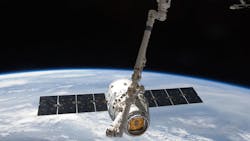Commercial SpaceX's Capsule Arrives at Space Station
WASHINGTON -- A privately-owned unmanned U.S. space capsule docked Sunday at the International Space Station bringing food, scientific materials and crucial equipment to the space outpost.
NASA said that SpaceX's Dragon capsule linked up with the ISS's Harmony module at 8:56 a.m.
The U.S. space agency said a hatch between Dragon and the ISS's Harmony module would be opened Monday as the capsule commenced its three-week-long stay at the orbiting space station.
"It's a critical achievement that we once again have a U.S. capability to transport science to and from the International Space Station," said William Gerstenmaier, NASA's associate administrator for the human exploration and operations directorate.
He added that the experiments "carry the promise of discoveries that benefit Earth and dramatically increase our understanding of how humans adapt to space."
Dragon was captured with the help of a robotic arm by NASA Expedition 34 Commander Kevin Ford and Flight Engineer Tom Marshburn, at 5:31 a.m., when the ISS was over northern Ukraine, U.S. space officials said.
The craft, after being inspected via cameras, was brought to the Earth-facing port of the Harmony module and bolted into place by commands from mission control.
The original plan had been for Dragon to attach to the space station on Saturday, but the capsule ran into troubles with its thrusters shortly after Friday's launch from Cape Canaveral, Fla., triggering the delay.
SpaceX engineers found that only one of the spacecraft's four thruster pods, which help maneuver the capsule in orbit, was working, but the malfunction was fixed.
The snafu has not delayed the capsule's splashdown, which remains scheduled for March 25, NASA said.
Dragon is carrying 1,200 pounds of supplies on SpaceX's second resupply mission to the ISS.
Scientists said the capsule will go home much heavier than it arrived, after the ISS offloads equipment from several experiments. Dragon is scheduled to bring home nearly double the amount of supplies it brought up, about 2,668 pounds.
One of the experiments is designed to study molecular changes to a small flowering plant called thale cress in microgravity. A related study examines how the plants' root hold up in low-oxygen environments.
NASA said that the experiments "will improve efforts aimed at growing food in space -- a crucial component of long-duration missions to Mars or elsewhere in the solar system. It can also inform crop production here on Earth."
Third Commercial Voyage
The voyage is the third commercial mission by the private SpaceX -- whose name is short for Space Exploration Technologies -- to the orbiting space station under contract with NASA.
In May 2012, SpaceX made history when Dragon became the first commercial spacecraft in history to successfully attach to the International Space Station.
Previously only four governments -- the United States, Russia, Japan and the European Space Agency -- had achieved this challenging technical feat.
SpaceX has now begun regular missions to the Space Station, completing its first official resupply mission in October 2012.
NASA is relying on SpaceX and other commercial ventures to take over for its retired fleet of space shuttles, which last flew in July 2011.
Before SpaceX's successful mission in October, NASA had been relying on Russian spacecraft -- but the Soyuz craft does not have room for cargo on the return flight.
SpaceX says it has 50 launches planned -- both NASA missions and commercial flights -- totaling about $4 billion in contracts.
So far, SpaceX has only sent unmanned flights into orbit, but the company aims to send a manned flight within the next three or four years. It is under a separate contract with NASA to refine the capsule so that it can carry a crew.
NASA also has a $1.9 billion resupply contract for the station with Orbital Sciences Corporation, which will launch the first test flight of its Antares rocket from a base in Virginia in the coming weeks.
The cargo for the 25-day mission includes equipment for 160 experiments to be conducted by the space station crew, which currently consists of two Americans, three Russians and a Canadian.
Jean-Louis Santini, AFP
Copyright Agence France-Presse, 2013
About the Author
Agence France-Presse
Copyright Agence France-Presse, 2002-2025. AFP text, photos, graphics and logos shall not be reproduced, published, broadcast, rewritten for broadcast or publication or redistributed directly or indirectly in any medium. AFP shall not be held liable for any delays, inaccuracies, errors or omissions in any AFP content, or for any actions taken in consequence.
